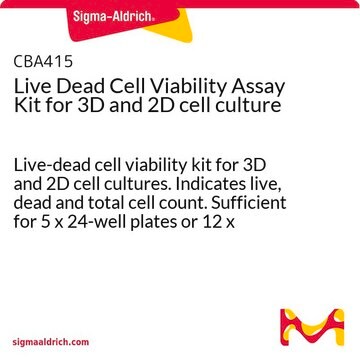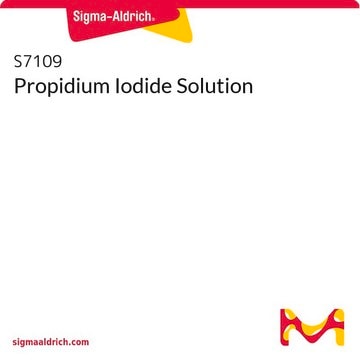Recommended Products
usage
sufficient for 5 96-well plate(s)
Quality Level
packaging
pkg of 1 kit
manufacturer/tradename
Roche
storage condition
protect from light
fluorescence
λex 361 nm; λem 486 nm (nuclei dye)
λex 490 nm; λem 515 nm (viable dye)
λex 535 nm; λem 617 nm (dead dye)
detection method
fluorometric
shipped in
dry ice
storage temp.
−20°C (−15°C to −25°C)
General description
The Cell Viability Imaging Kit is a simple and rapid way to measure mammalian cell viability using fluorescence microscopy and automated imaging platforms, such as the Cellavista System. Optimized for 96-well plates, the numbers of viable and dead cells, as well as total cell numbers, are determined simultaneously for the area of the well selected.
The kit is designed for 5 × 96 reactions for use in medium to high throughput analysis of cell behavior.
- Determine total cell number using fluorescence staining of cell nuclei.
- Fluorimetrically determine the percentage of dead cells based on membrane permeability.
- Verify the labeling of viable cells quantified by fluorescence staining using a vital dye
Application
Cell quantification and cell viability control are very important methods in cell biology. This includes both life science research and industrial applications. The simple, accurate and fast “one step assay” makes the Cell Viability Imaging Kit an ideal tool for quality control of cells in cellular workflows, especially for medium to high throughput applications.
Features and Benefits
Cell counting and cell viability are essential for cellular workflows. The Roche Cell Viability Imaging Kit meets the following requirements:
- No risk of losing cells in the one step assay: There are no fixation or washing steps.
- Save time and resources: Total assay time for a 1 x 96 well microplate is only 35 minutes.
- Obtain highly reproducible results using automated imaging and data evaluation with Roche′s Cellavista System.
Packaging
1 kit containing 3 components.
Preparation Note
Storage conditions (working solution): Vial 3: The product is stable until the expiration date printed on the label when stored at -15 to -25 °C. Contents can be frozen and thawed at least 5 times after preparation of solution.
Storage and Stability
Store at -15–-25 °C. (Vial 1 and Vial 2 can be frozen and thawed at least 5 times. Vial 3 can be frozen and thawed at least 5 times after preparation of solution.)
Other Notes
For life science research only. Not for use in diagnostic procedures.
Kit Components Only
Product No.
Description
- Nuclei Dye (blue cap) for fluorimetric determination of cell count based on labeling of cell nuclei
- Dead Dye (red cap) for fluorimetric determination of dead cells based on cell permeability
- Viable Dye ( green cap) for fluorimetric determination of viable cells based on metabolic activity
Signal Word
Warning
Hazard Statements
Precautionary Statements
Hazard Classifications
Muta. 2
Storage Class Code
12 - Non Combustible Liquids
WGK
nwg
Flash Point(F)
Not applicable
Flash Point(C)
Not applicable
Certificates of Analysis (COA)
Search for Certificates of Analysis (COA) by entering the products Lot/Batch Number. Lot and Batch Numbers can be found on a product’s label following the words ‘Lot’ or ‘Batch’.
Already Own This Product?
Find documentation for the products that you have recently purchased in the Document Library.
Customers Also Viewed
Fengliang Wang et al.
Molecular medicine reports, 16(4), 5441-5449 (2017-08-30)
Previous studies have reported that angelicin exerted antiproliferative effects on several types of tumor cell. However, to the best of our knowledge, the effects of angelicin monotherapy on human liver cancer remain to be investigated. In the present study, the
Kun Xiao et al.
Gut pathogens, 13(1), 63-63 (2021-10-21)
The liver plays an important role in production and metabolism of homocysteine (Hcy), which has been reported to be involved in liver injury. In our previous work, we confirm that Hcy can induce liver injury by activating endoplasmic reticulum (ER)
Lingbo Xu et al.
Molecular medicine reports, 23(6) (2021-04-22)
Our previous study reported that microRNA (miR)‑30a‑5p upregulation under hypoxia postconditioning (HPostC) exert a protective effect on aged H9C2 cells against hypoxia/reoxygenation injury via DNA methyltransferase 3B‑induced DNA hypomethylation at the miR‑30a‑5p gene promoter. This suggests that miR‑30a‑5p may be
Our team of scientists has experience in all areas of research including Life Science, Material Science, Chemical Synthesis, Chromatography, Analytical and many others.
Contact Technical Service












